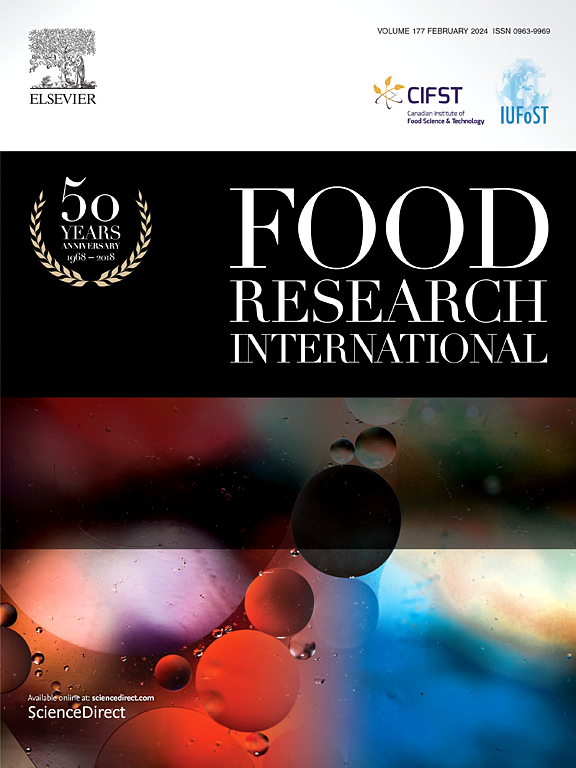Effects of ultrasonication on the emulsification behavior and nutritional properties of myofibrillar protein-tussah pupa (Antheraea pernyi) protein complexes: A multiscale investigation
IF 7
1区 农林科学
Q1 FOOD SCIENCE & TECHNOLOGY
引用次数: 0
Abstract
Tussah pupa protein (TPP), rich in diverse bioactive components and demonstrating extensive physiological activities, has attracted attention in food processing. However, its limited emulsion stability restricts application potential, requiring improvement of techno-functional properties. The effects of myofibrillar protein (MP) compounding coupled with ultrasonic treatment on the emulsifying properties and nutritional value of TPP were systematically investigated from a multi-scale perspective in this study. The results demonstrated that ultrasonic treatment significantly reduced particle size and enhanced electrostatic repulsion (P < 0.05). Ultrasonic cavitation triggered a structural transition from α-helix to β-sheet, leading to increased exposure of tryptophan residues, enhanced disulfide bond formation, and strengthened hydrophobic interactions, which collectively contributed to the spatial reorganization of the composite protein. CLSM and SEM analyses further revealed that ultrasonication generated smaller, uniformly dispersed particles with irregular morphologies, thereby facilitating the formation of a more stable emulsion system. Amino acid analysis revealed that ultrasonication significantly elevated the amino acid score (AAS) and essential amino acid index (EAAI) (P < 0.05), demonstrating closer alignment with FAO/WHO standards for human nutritional needs. Furthermore, the enhanced exposure of antioxidant amino acid residues further improved the protein's antioxidant activity. Notably, in vitro digestion simulations demonstrated that ultrasonicated samples, especially UMS, achieved significantly higher degradation efficiency during gastrointestinal digestion, suggesting improved digestibility and absorption potential. In summary, ultrasonication improved the emulsifying stability and nutritional quality of the composite protein emulsion, supporting its potential market applications.

超声对柞蚕蛹肌纤维蛋白复合物乳化行为和营养特性的影响:一项多尺度研究
柞蚕蛹蛋白(Tussah pupa protein, TPP)富含多种生物活性成分,具有广泛的生理活性,在食品加工中备受关注。但其乳液稳定性有限,限制了其应用潜力,需要进一步提高其工艺功能性能。本研究从多尺度角度系统研究了肌纤原蛋白(myofibrar protein, MP)复合配合超声处理对TPP乳化性能和营养价值的影响。结果表明,超声处理显著减小了颗粒尺寸,增强了静电斥力(P <;0.05)。超声空化触发了结构从α-螺旋向β-片的转变,导致色氨酸残基暴露增加,二硫键形成增强,疏水相互作用增强,这些共同促进了复合蛋白的空间重组。CLSM和SEM分析进一步表明,超声作用产生的颗粒更小,分散均匀,形态不规则,有利于形成更稳定的乳液体系。氨基酸分析显示,超声可显著提高氨基酸评分(AAS)和必需氨基酸指数(EAAI) (P <;0.05),表明更符合粮农组织/世卫组织关于人类营养需求的标准。此外,抗氧化氨基酸残基暴露的增加进一步提高了蛋白质的抗氧化活性。值得注意的是,体外消化模拟表明,超声处理后的样品,特别是UMS,在胃肠道消化过程中具有明显更高的降解效率,表明其消化率和吸收潜力有所提高。综上所述,超声处理改善了复合蛋白乳液的乳化稳定性和营养品质,支持其潜在的市场应用。
本文章由计算机程序翻译,如有差异,请以英文原文为准。
求助全文
约1分钟内获得全文
求助全文
来源期刊

Food Research International
工程技术-食品科技
CiteScore
12.50
自引率
7.40%
发文量
1183
审稿时长
79 days
期刊介绍:
Food Research International serves as a rapid dissemination platform for significant and impactful research in food science, technology, engineering, and nutrition. The journal focuses on publishing novel, high-quality, and high-impact review papers, original research papers, and letters to the editors across various disciplines in the science and technology of food. Additionally, it follows a policy of publishing special issues on topical and emergent subjects in food research or related areas. Selected, peer-reviewed papers from scientific meetings, workshops, and conferences on the science, technology, and engineering of foods are also featured in special issues.
 求助内容:
求助内容: 应助结果提醒方式:
应助结果提醒方式:


